Bay Area birds and climate change
By Ilana DeBare
Chickadees. Juncos. Woodpeckers….
These familiar Bay Area backyard birds are all at risk from climate change, according to a detailed new report released this month by the National Audubon Society.
Common local species such as Dark-eyed Juncos, Chestnut-backed Chickadees, Acorn Woodpeckers, and White-crowned Sparrows are among the 47 percent of California bird populations that will decline or even vanish if nothing is done to reduce greenhouse gas emissions.
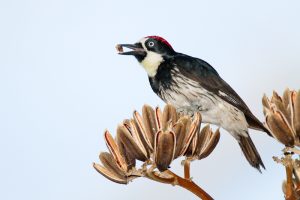
“What’s shocking is that the birds at risk are not just rare or endangered species, but our most beloved backyard and neighborhood birds,” said Pam Young, Executive Director of Golden Gate Bird Alliance. “These birds provide a warning of how climate change threatens all of our communities, lives, and health.”
The National Audubon report – which examined 604 North American bird species using 140 million bird records, including Christmas Bird Count data – is the most detailed study so far of how climate change will affect birds, both nationally and on a local level.
It looked at how birds will fare under three climate scenarios including an increase of 3 degrees Celsius, the amount that average temperatures are projected to rise by 2080 if no preventive actions are taken.
Along with the report, NAS rolled out an online Climate Change Visualizer tool that allows people to view the expected impact of climate change on birds in their local area.
In California as a whole, the species most at risk are birds that depend on forests and arid lands for habitat.
In Alameda County, 66 out of 172 species studied are projected to lose more than half of their current nationwide range. In San Francisco, 60 out of 152 species will lose more than half of their nationwide range.
The specific threats vary by species but include higher temperatures, drought, wildfires, and sea level rise. Changes in the timing of seasons can deprive migratory birds of food sources like insects; extreme springtime temperatures can disrupt breeding and kill nestlings.
In some cases, the Bay Area itself may become less habitable for birds. In other cases, our migratory visitors may dwindle due to loss of breeding habitat elsewhere. In a few cases, loss of habitat in other parts of North America will make the Bay Area an even more important home for remnants of a dwindling species.
Here are some snapshots of Bay Area birds at risk, and the different ways that a temperature rise of 3 degrees Celsius (5.4 degrees Fahrenheit) could affect them:
White-crowned Sparrows. Some of these backyard favorites stay in the Bay Area year-round, but most fly north to breed each summer and return in early fall. As temperatures rise, their breeding territory will be pushed further and further north, into a narrow strip near the Arctic that may be insufficient to sustain them. We may no longer see them in the Bay Area in the summer at all, and their numbers in winter may drop.
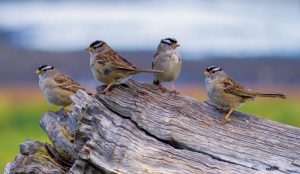
Acorn Woodpeckers.Their clownlike faces and noisy colonies are a vivid part of Bay Area wooded hillsides. Although their summer range will expand in some parts of North America by 19 percent, they will lose much more than they gain – 57 percent of their current territory. Areas that may no longer support them include the Sierra foothills and parts of the East Bay hills.
Allen’s Hummingbird. This orange-colored hummingbird is currently less common here than in Southern California. Warmer temperatures will eliminate 94 percent of its current winter range and push it north to the Central California coast and the Bay Area. If we want climate-refugee species like Allen’s Hummingbird to survive, it’s critical that we provide adequate habitat – parks, backyards, and other natural spaces filled with native plants.
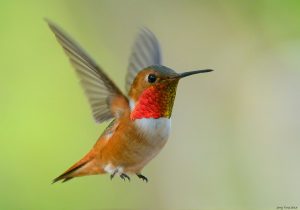
Dark-eyed Junco. These sparrow-sized birds are easily recognizable by their black hooded heads. Their winter range in the Bay Area will remain stable, but hotter temperatures will reduce their summer range throughout the continent by 52 percent. They may maintain summer populations along the cooler coasts of Marin and San Francisco, but most of the East Bay will become seasonally uninhabitable for them.
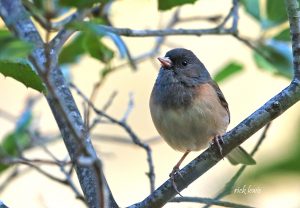
Common Goldeneye. These striking ducks are winter visitors to the Bay shoreline. They currently breed in the summer across much of Canada, but climate change will reduce their breeding range by 60 percent and push them, like many other species, up to a narrow band in the Arctic. Less room and fewer resources for breeding probably means fewer Goldeneyes along our Bay shoreline each winter.
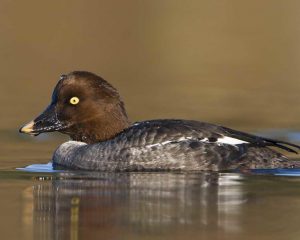
Wilson’s Warbler. These colorful migrants will no longer spend summers in the Bay Area; they’ll move north into Canada seeking cooler temperatures. Continent-wide, they’ll lose 61 percent of their current summer range, more than offsetting the 18 percent additional range they may gain.

Chestnut-backed Chickadee. A favorite feeder bird, our West Coast chickadees will gain a lot of year-round habitat in Canada but lose habitat here in Northern California. Their threats include extreme springtime heat that can imperil nestlings and heavy rainstorms that can flood nests. Our grandchildren may have to travel to Washington state or Vancouver to hear that familiar dee-dee-dee call.
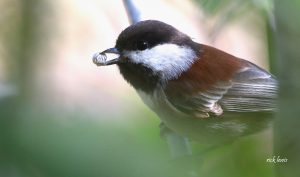
As distressing as the prospect of a Bay Area without chickadees or warblers may be, National Audubon officials insist that the report provides hope as well as gloom.
They note that one of the climate scenarios – an average global increase of just 1.5 rather than 3 degrees – would save most of the continent’s threatened bird species. (The Intergovernmental Panel on Climate Change recommends stabilizing warming at 1.5 degrees Fahrenheit.)
There are a variety of steps that people can take to limit climate change. Some of these are old hat to climate-savvy Bay Area residents – steps such as reducing individual energy use, advocating for clean energy sources, creating fiscal incentives to reduce greenhouse gases such as a carbon tax, and electing officials who are climate champions.
But there are other steps more specific to birds and wildlife. It’s important for Audubon members to promote these, since they typically get less attention than broader measures like reducing energy use:
- Restore wetlands along the Bay that will provide homes to birds, serve as carbon storage banks, and protect bayside communities from sea level rise.
- Preserve forests and grasslands that are habitat for birds.
- Landscape with native plants that offer food and shelter to birds.
- Increase housing density in urban cores, so there is less development pressure on open fields and woodlands.
- Monitor wind and solar energy projects to ensure they’re implemented in ways that don’t jeopardize birds.
- Support other measures to protect birds such as bird-safe building practices, keeping cats indoors, keeping dogs on leash in natural areas, and avoiding rodenticides that cause secondary poisoning of raptors. Although these are not directly climate-related, they can make a life-or-death difference for species in trouble due to climate change.
“Two-thirds of America’s birds are threatened with extinction from climate change, but keeping global temperatures down will help up to 76 percent of them,” said David Yarnold, CEO of National Audubon. “There’s hope in this report, but first, it’ll break your heart if you care about birds and what they tell us about the ecosystems we share with them. It’s a bird emergency.”
Golden Gate Bird Alliance offers a variety of opportunities to help protect birds in the face of climate change, such as restoring habitat along the Bay shoreline or joining one of our conservation committees. See goldengatebirdalliance.org/volunteer/.
We also encourage you to visit the National Audubon climate web site and explore the online tool that shows threatened species in your area, and how they will fare under different warming scenarios. See audubon.org/climate/survivalbydegrees.
Please share the National Audubon site and its information with your neighbors, friends, and family. It’s a potential valuable tool in getting people to understand and act on climate change. Even your most conservative red-state relatives have backyard birds: The threat to their favorite warbler or chickadee may be the thing that opens their eyes to climate change.


